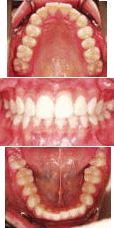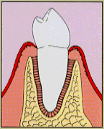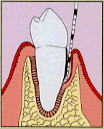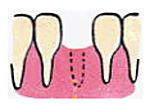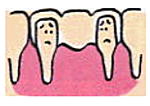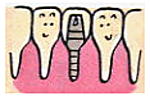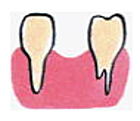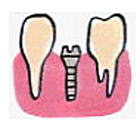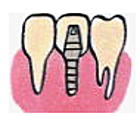There is a way to eat with your own teeth for a lifetime
"Immortality" is said to be a dream of humanity. Then, is "eating
with your own teeth for a lifetime" also a dream?
Currently, Japanese people begin to lose their teeth rapidly around the
age of 50, and many have dentures by the age of 70.
With the methods our country has used until now, "eating with your
own teeth for a lifetime" has been an unattainable dream.
On the other hand, scientific research results from the past ten years
have shown that teeth do not fall out as we age, and it is possible to
eat with our own teeth no matter how old we get.
Moreover, it is simple and can be done by anyone. "Eating with your
own teeth for a lifetime" is a true dream.
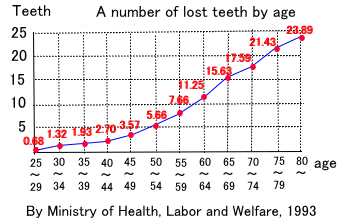 |
Teeth are a lifelong treasure. Therefore, let's take good care of them and use them well.
|
Teeth begin to form while you are still in your mother's womb. Then, around six months after birth, baby teeth start to come in and are usually all in place by about two years old. After that, around the age of six, permanent teeth begin to come in and are usually all in place by about fifteen years old. And then you will use these teeth for a lifetime, about 70 years. Every single day, they endure harsh work, "undeterred by candy or colds." Do you have anything around you that you use for 70 years? Even the best Japanese cars in the world last only about ten years. That's why we want you to take good care of your teeth. There are many dental problems and points to be aware of at each age, but here, we will explain how to prevent cavities in children and how adults can avoid losing their teeth. |
 |
Children's cavities can be reliably prevented by using fluoride properly
When it comes to preventing cavities, the first thing that comes to mind is brushing your teeth, right? But don't you feel like "I brush my teeth, but still get cavities"? In fact, there is a more reliable method than brushing. It is to use fluoride properly.
Japan has the highest number of cavities (including both treated and untreated) among developed countries. And all the countries that have successfully prevented cavities use fluoride properly.
For example, the United States has successfully reduced cavities by adding fluoride to tap water. It is said that Japanese people brush their teeth more often than Americans and eat only about half as many sweets. Despite this, the number of cavities in Japanese people is higher because the use of fluoride is not sufficient. Now, fluoride is used as a trump card against cavities in many countries around the world, and the majority of children have no cavities at all.
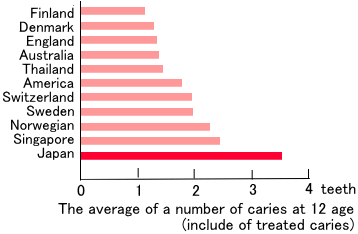 |
||||||
|
In adults, we will eliminate cavities and periodontitis to keep teeth healthy
In adulthood, in addition to cavities, attention to periodontitis becomes necessary.
Periodontitis is a disease where the bone supporting the teeth (periodontal bone) dissolves, and in severe cases, the teeth may fall out.
In its early stages, it only has mild symptoms such as slight pain and bleeding when brushing, and it is usually not noticed until it has progressed significantly. Additionally, most people over the age of 40 have periodontitis, making it the leading cause of tooth loss.
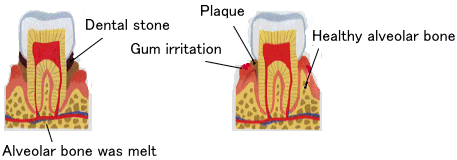 |
The bacteria (plaque) that accumulates at the boundary between the teeth and gums causes tartar to form and the alveolar bone to dissolve. Additionally, periodontitis has been found to cause or worsen systemic diseases such as stroke, heart disease, diabetes, and pneumonia. Although it is a frightening disease, fortunately, with proper treatment, it can be very effectively cured, and recurrence is almost entirely prevented. So, how is periodontitis treated?
First, the most important thing is plaque control as home care, where the patient removes the plaque by brushing their teeth. Do you think, "I brush my teeth every day, so I'm fine"? This is actually a major pitfall, as more than 70% of people who have not received professional guidance have plaque buildup. Additionally, detailed guidance from professionals (dentists and dental hygienists) is necessary to effectively remove plaque.
For example, at our dental clinic, we provide this guidance to most patients about ten times. This helps find the plaque control method that suits each patient. This step is the most important and takes time. Second, as professional care, specialists remove the plaque and tartar that the patient cannot remove themselves (scaling and root planing). Removing tartar completely requires advanced techniques.
Most periodontitis can be cured with this home care and professional care. Also, with proper maintenance, recurrence does not occur. On the other hand, periodontitis that does not heal is mainly due to inappropriate home care and professional care.
"Eating with your own teeth for a lifetime" is being realized
It has been scientifically proven that with proper home care and professional care for cavities and periodontitis, one can eat with their own teeth for a lifetime. A prime example is the program developed by Professor Axelsson, which was implemented for people in a certain region in Scandinavia who had about 20 of their own teeth. With this method, each person lost only 0.2 teeth and developed about one new cavity over 15 years, and periodontitis was almost entirely eliminated. Only 3% of people stopped this program within 15 years, showing how comfortable it is. Moreover, there was almost no difference due to age, allowing people to eat with their own teeth regardless of age. This method has gained attention in Japan and is being implemented at our clinic as well.
The 15-year results after providing proper home care and professional care to 375 people
|
||||||||||||||||||||||
Don't Give Up on Severe Periodontitis
In recent years, treatments using special artificial membranes and proteins to restore ligaments and bones lost due to periodontitis (such as the GTR method) have been developed. This has made it possible to save teeth that would have needed to be extracted or were difficult to treat with traditional methods. Advanced techniques are required, so please consult us.
|
|||||||||
Implants Protect Your Remaining Teeth
In the unfortunate event of losing a tooth, the only option traditionally has been to use bridges or dentures to enable chewing. However, with treatment using bridges or dentures, the remaining teeth are often filed down or fitted with clasps, which can cause issues after 5 to 10 years. Many people lament, "At first, I lost just one tooth, but before I knew it, several teeth were damaged..." Implants are a very effective treatment to prevent such problems.
Our teeth extend roots (tooth roots) into the alveolar bone. To mimic this structure, a titanium artificial root is placed into the alveolar bone after a tooth is lost. The treatment, where a crown is then placed on this artificial root, is known as implant treatment.
Because artificial roots bond well with the bone, this treatment is recognized as the most reliable and is highly valued internationally. Furthermore, technological advances have made it possible to apply implants even in areas with previously insufficient bone.
With implants, there is no need for bridges or dentures, and you can chew as if they were your own teeth. Most importantly, the biggest advantage is that implants do not burden the remaining teeth, thereby protecting your natural teeth. Please feel free to consult us.
Protect Adjacent Teeth with Implants
|
||||||||
The Process of Implant Treatment
|
||||||||
Because artificial roots bond well with the bone, this treatment is recognized as the most reliable and is highly valued internationally. Furthermore, technological advances have made it possible to apply implants even in areas with previously insufficient bone.
With implants, there is no need for bridges or dentures, and you can chew as if they were your own teeth. Most importantly, the biggest advantage is that implants do not burden the remaining teeth, thereby protecting your natural teeth. Please feel free to consult us.
Let's Eat with Our Own Teeth for a Lifetime through Non-invasive Treatment and Prevention
In 20th-century treatments, even painful teeth could be drilled and filled to enable chewing. Additionally, missing teeth could be replaced with bridges or dentures to restore chewing ability. However, these methods alone did not extend the lifespan of the teeth.
Today, in the 21st century, based on further scientific advances in dentistry, non-invasive treatment and prevention have become a reality. Let us all enjoy this blessing and maintain the ability to eat with our own teeth for a lifetime, ensuring healthy daily lives!
| -Back to top- |


